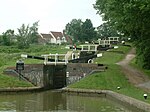Daventry Rural District
Districts of England abolished by the Local Government Act 1972Districts of England created by the Local Government Act 1894History of NorthamptonshireRural districts of EnglandUse British English from August 2012
The Daventry Rural District was a rural district in Northamptonshire, England from 1894 to 1974. It entirely surrounded the municipal borough of Daventry. The district was administered from Daventry but did not include the town. It was formed under the Local Government Act 1894 based on Daventry rural sanitary district. It was expanded in 1935, by a County Review Order, by taking over the parishes of the former Crick Rural District. In 1974, under the Local Government Act 1972, the district was abolished, being merged with Daventry and with most of Brixworth Rural District to form a new district of Daventry.
Excerpt from the Wikipedia article Daventry Rural District (License: CC BY-SA 3.0, Authors).Daventry Rural District
Geographical coordinates (GPS) Address Nearby Places Show on map
Geographical coordinates (GPS)
| Latitude | Longitude |
|---|---|
| N 52.3 ° | E -1.15 ° |
Address
NN11 2LJ , Ashby St Ledgers
England, United Kingdom
Open on Google Maps











